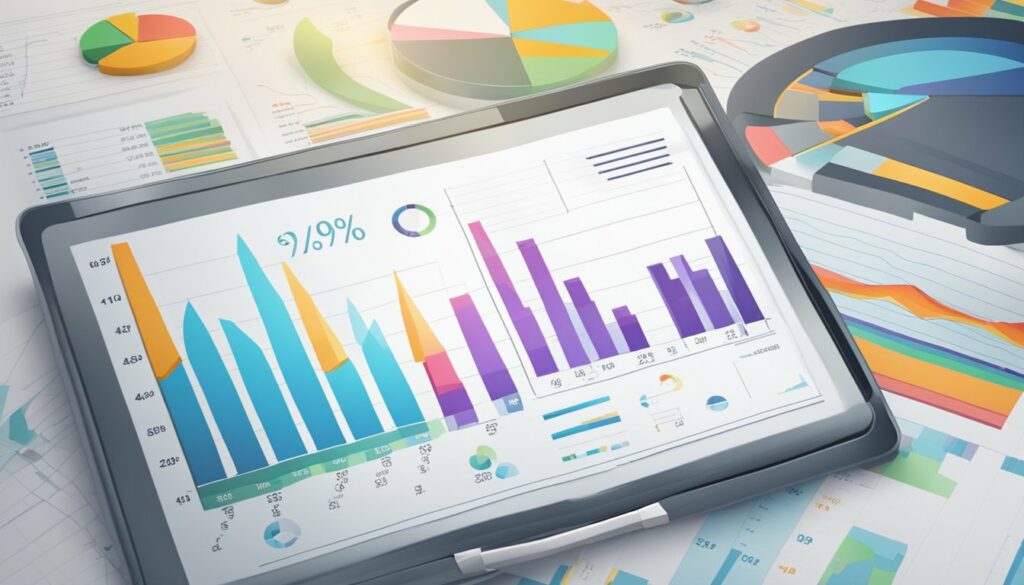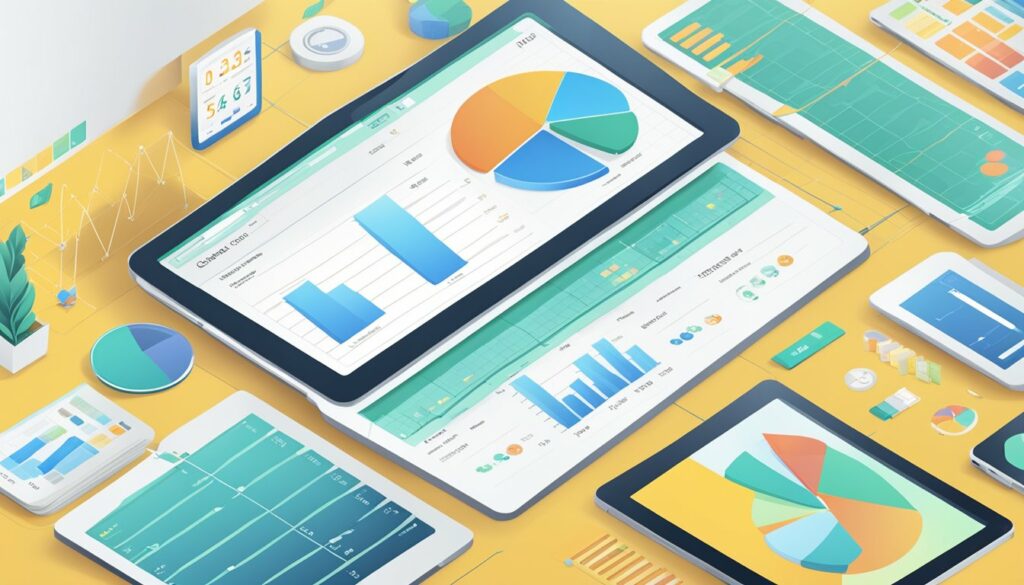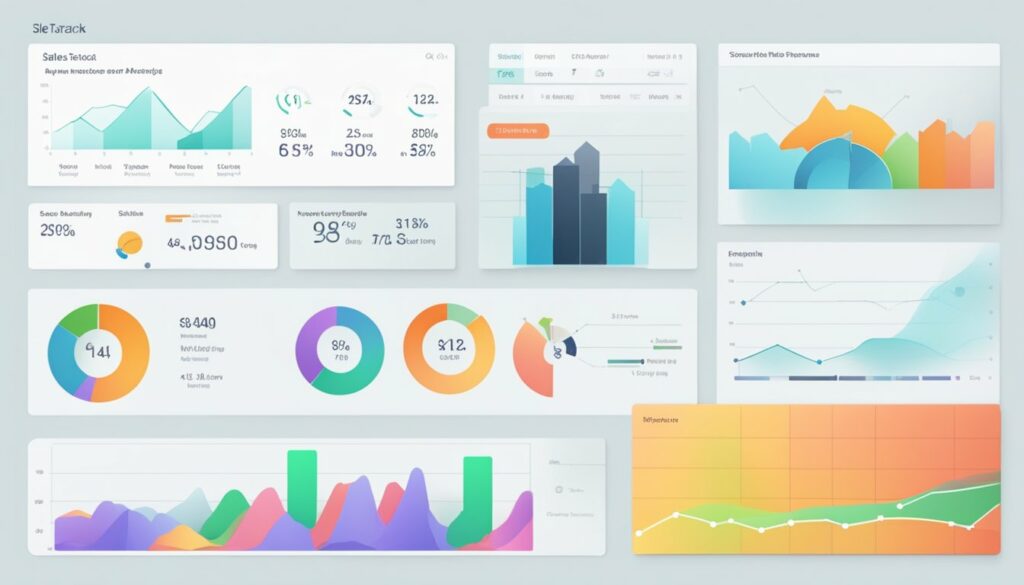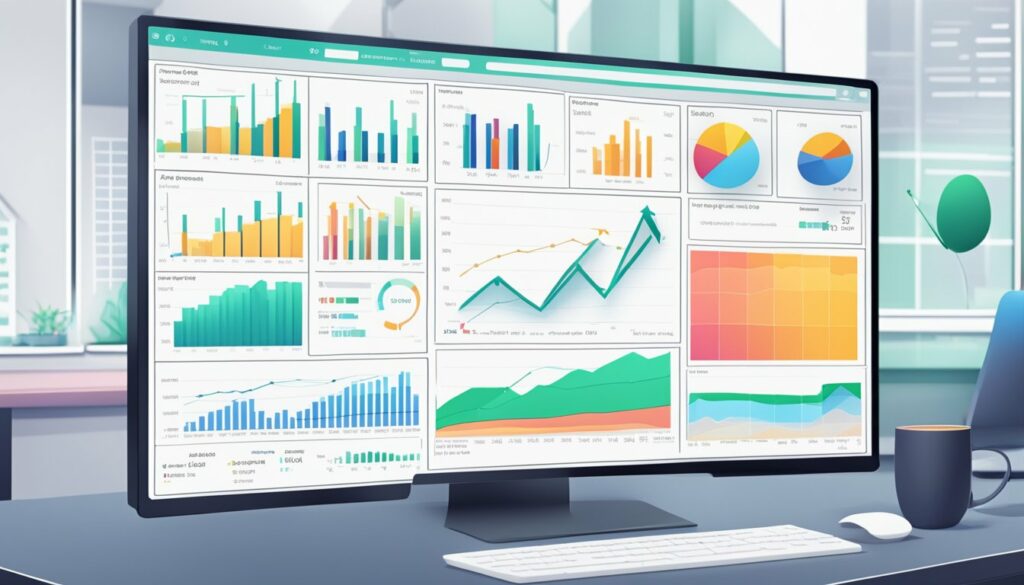The ultimate tool for monitoring a business’s performance with a sales tracker is a comprehensive software that offers real-time data analysis, tracks sales metrics, forecasts trends, and provides actionable insights to drive strategic decision-making. This tool should integrate with other business systems for a holistic view.
Sales tracking is an essential part of any business that wants to stay competitive and grow. It involves monitoring and analyzing sales data to gain insights into customer behavior, product performance, and overall business trends.
A sales tracker is a tool that helps businesses automate the process of tracking and analyzing sales data, allowing them to make more informed decisions and improve their sales processes.

Understanding sales tracking is crucial for any business that wants to stay ahead of the competition. Sales tracking involves monitoring sales data to identify trends, patterns, and opportunities for improvement. By tracking sales data, businesses can gain insights into customer behavior, product performance, and overall business trends. This information can then be used to make more informed decisions about marketing, sales, and product development.
Sales tracking fundamentals include identifying key performance indicators (KPIs) such as revenue, profit margins, and customer acquisition costs. Businesses can use these KPIs to measure the success of their sales efforts and identify areas for improvement. Sales tracking tools and software can help automate the process of tracking and analyzing sales data, making it easier for businesses to stay on top of their sales performance.
Key Takeaways
- Sales tracking is an essential part of any business that wants to stay competitive and grow.
- By tracking sales data, businesses can gain insights into customer behavior, product performance, and overall business trends.
- Sales tracking tools and software can help automate the process of tracking and analyzing sales data, making it easier for businesses to stay on top of their sales performance.
Understanding Sales Tracking
Sales tracking is the process of monitoring and analyzing sales data to gain insights into a company’s sales performance. It involves collecting and analyzing data on sales activities, such as the number of units sold, revenue generated, and customer demographics. This information can be used to identify trends and opportunities for improvement, as well as to make informed decisions about sales strategies and tactics.
Importance of Sales Tracking
Sales tracking is essential for businesses of all sizes, as it provides valuable insights into sales performance. By tracking sales data, companies can identify which products or services are selling well, which ones are not, and which customer segments are most profitable. This information can be used to optimize sales strategies and improve overall business performance.
Key Sales Metrics
There are several key metrics that companies should track when conducting sales tracking. These include:
- Sales revenue: The total amount of money generated from sales.
- Sales volume: The total number of units sold.
- Average order value: The average amount of money spent per order.
- Customer acquisition cost: The cost of acquiring a new customer.
- Customer lifetime value: The total amount of money a customer is expected to spend over their lifetime.
Sales Tracking vs. Sales Forecasting
Sales tracking is often confused with sales forecasting, but the two are distinct processes. Sales tracking involves monitoring and analyzing past sales data, while sales forecasting involves predicting future sales based on historical data and other factors. Both are important for effective sales management, but they serve different purposes.
To learn more about sales tracking, check out this Sales Tracking Guide, which provides a detailed overview of the process and its benefits.
Sales Tracking Fundamentals
Sales tracking is an essential aspect of any business as it helps to monitor the progress of sales activities and identify areas that require improvement. A sales tracker is a tool that assists in tracking sales and analyzing data to make informed decisions. In this section, we will discuss the fundamental components of a sales tracker, setting up sales goals, and tracking sales activities.
Components of a Sales Tracker
A sales tracker template typically includes the following components:
- Sales goals: This involves setting targets for sales revenue, units sold, or new customers acquired.
- Sales activities: These are the actions taken to achieve the sales goals, such as cold calling, email marketing, or networking events.
- Sales funnel: This is the process of converting leads into customers, which includes stages such as prospecting, qualifying, and closing the sale.
- Templates: These are pre-designed forms or spreadsheets that help to organize and record sales data.
Setting Up Sales Goals
Setting up sales goals is an essential step in the sales tracking process. It involves identifying the desired outcomes and the specific metrics to measure success. Sales goals should be SMART (specific, measurable, achievable, relevant, and time-bound) to ensure that they are realistic and attainable.
The sales tracker should be able to track progress towards the sales goals and provide insights into the effectiveness of sales strategies. It is crucial to review and adjust sales goals regularly to ensure that they align with the overall business objectives.
Tracking Sales Activities
Tracking sales activities involves recording the actions taken to achieve the sales goals. This includes keeping track of the number of calls made, emails sent, and meetings scheduled. The sales tracker should be able to generate reports that show the effectiveness of each sales activity and help to identify areas that require improvement.
It is important to ensure that the sales tracker is updated regularly to provide accurate data. This will help to make informed decisions and improve the overall sales performance.
In conclusion, sales tracking is a fundamental aspect of any business that aims to improve its sales performance. By using a sales tracker, businesses can monitor sales activities, set up sales goals, and track progress towards achieving those goals. With the right data and insights, businesses can make informed decisions and improve their overall sales performance.
Here is a link to an external resource that provides more information on sales tracking software.
Sales Tracking Tools and Software
Sales tracking tools and software have become essential for businesses of all sizes to manage their sales pipeline efficiently. With the help of CRM systems and sales tracking software, businesses can streamline their sales processes, track their leads, and close more deals. In this section, we will look at some of the popular sales tracking tools and software available in the market.
CRM Systems
Customer Relationship Management (CRM) systems are designed to manage a company’s interactions with its customers and prospects. They provide a centralized database to store customer information, track sales activities, and manage customer communication. Some of the popular CRM systems are HubSpot, Pipedrive, and Bitrix24.
HubSpot is an all-in-one CRM that offers sales, marketing, and customer service tools. It provides a user-friendly interface and offers a range of features such as lead tracking, deal tracking, and email tracking. Pipedrive is another popular CRM that focuses on sales pipeline management. It offers a visual sales pipeline, customizable sales stages, and deal tracking. Bitrix24 is a comprehensive CRM that offers a range of features such as sales automation, project management, and communication tools.
Sales Tracking Software Features
Sales tracking software offers a range of features to help businesses manage their sales pipeline efficiently. Some of the common features include lead tracking, deal tracking, email tracking, and sales automation. Sales tracking software also offers customization options to tailor the software to the business’s specific needs.
Automation is one of the critical features of sales tracking software. It helps businesses automate their sales processes, such as lead nurturing and follow-up. Customization is another important feature that allows businesses to customize the software to their specific needs. Sales tracking software also offers integrations with other tools such as marketing automation software, accounting software, and project management software.
Choosing the Right Sales Tracker
Choosing the right sales tracker depends on the business’s specific needs and requirements. Businesses should consider factors such as functionality, automation, customization, and integrations when choosing a sales tracker. They should also consider the pricing and support options offered by the sales tracker.
Businesses should look for a sales tracker that offers a mobile app to manage their sales pipeline on the go. They should also consider the level of support offered by the sales tracker, such as training and customer support. Finally, businesses should read reviews and compare different sales trackers before making a decision.
In conclusion, sales tracking tools and software are essential for businesses to manage their sales pipeline efficiently. CRM systems and sales tracking software offer a range of features to help businesses track their leads, manage their sales activities, and close more deals. Businesses should choose a sales tracker that meets their specific needs and requirements, offers a range of features, and provides excellent support.
Sales Data Management

Sales data management is an essential aspect of any business, as it helps to keep track of sales performance and identify areas for improvement. In this section, we will explore the different stages of sales data management, from collecting and organizing data to analyzing sales data and reporting and visualization.
Collecting and Organizing Data
The first step in sales data management is collecting and organizing data. This involves gathering data from various sources, such as sales transactions, customer interactions, and marketing campaigns. The data is then organized into a structured format, such as a spreadsheet or database, to make it easier to analyze.
To ensure accurate data collection, it is essential to have a standardized process in place. This includes defining the data to be collected, establishing data collection methods, and assigning responsibilities for data entry and management.
Analyzing Sales Data
Once the data has been collected and organized, the next step is to analyze it. This involves using various analytical tools and techniques to identify patterns, trends, and insights. Some common sales metrics used for analysis include revenue, profit margin, customer acquisition cost, and customer lifetime value.
Sales analytics can provide valuable insights into customer behavior, sales performance, and market trends. By analyzing sales data, businesses can identify areas for improvement, optimize sales strategies, and make data-driven decisions.
Reporting and Visualization
The final stage of sales data management is reporting and visualization. This involves presenting the analyzed data in a clear and concise format, such as a sales report or dashboard. The report should include key performance indicators (KPIs) and metrics, such as revenue, sales growth, and customer satisfaction.
Data visualization is an effective way to communicate complex data in a simple and easy-to-understand format. It can help to identify trends and patterns quickly and make data-driven decisions. There are various data visualization tools available, such as Tableau, Power BI, and Google Data Studio.
In conclusion, sales data management is a critical aspect of any business. By collecting, analyzing, and reporting sales data, businesses can gain valuable insights into their sales performance, optimize sales strategies, and make data-driven decisions. To learn more about sales data management, check out this resource.
Improving Sales Processes

Improving sales processes is a critical aspect of any business looking to increase sales performance and conversion rates. Identifying bottlenecks, optimizing sales processes, and implementing effective sales strategies are all essential steps in this process.
Identifying Bottlenecks
Identifying bottlenecks in the sales process is the first step towards improving sales performance. Bottlenecks can occur at any stage of the sales process, from lead generation to closing deals. To identify bottlenecks, businesses need to analyze their workflows and identify areas where the process slows down or stalls.
Once bottlenecks are identified, businesses can prioritize the areas that need improvement and work towards optimizing the sales process.
Sales Process Optimization
Sales process optimization involves streamlining the sales process to improve sales performance and conversion rates. This can be achieved by identifying and removing bottlenecks, automating tasks, and improving workflows.
One effective way to optimize the sales process is by using a sales tracker. A sales tracker can help businesses track their sales performance, identify areas of improvement, and prioritize tasks. By using a sales tracker, businesses can streamline their sales process, improve their conversion rates, and increase their sales performance.
Implementing Sales Strategies
Implementing effective sales strategies is another critical aspect of improving sales performance. Businesses need to identify their target audience, understand their needs and pain points, and develop sales strategies that address these issues.
One effective sales strategy is to focus on customer relationships. By building strong relationships with customers, businesses can increase customer loyalty, improve their reputation, and increase their sales performance.
In conclusion, improving sales processes is essential for businesses looking to increase their sales performance and conversion rates. By identifying bottlenecks, optimizing workflows, and implementing effective sales strategies, businesses can streamline their sales process, improve their conversion rates, and increase their sales performance.
For more information on improving sales processes, businesses can refer to this article by Salesforce.
Lead and Customer Management

Sales Tracker provides a comprehensive solution for managing leads and customers in one place. This section covers the key features of lead and customer management, including lead generation and tracking, managing customer relationships, and customer retention strategies.
Lead Generation and Tracking
Sales Tracker makes it easy to generate and track leads with its intuitive interface and powerful features. Users can create custom lead forms to capture contact information from prospects and automatically add them to their database. The system also includes lead scoring and qualification tools to help users prioritize their follow-up efforts and focus on the most qualified leads.
To learn more about lead generation and tracking, check out this article from Salesforce, a leading provider of CRM software.
Managing Customer Relationships
Sales Tracker provides a robust set of tools for managing customer relationships, including contact management, activity tracking, and communication tools. Users can easily view all interactions with a customer in one place, including emails, phone calls, and meetings. The system also includes automated follow-up reminders and task management tools to help users stay on top of their customer relationships.
To learn more about customer relationship management, check out this guide from HubSpot, a leading provider of marketing and sales software.
Customer Retention Strategies
Sales Tracker includes a variety of tools and features to help users retain customers and improve the overall customer experience. Users can create targeted marketing campaigns to engage customers and keep them coming back, as well as track customer satisfaction and feedback to identify areas for improvement.
To learn more about customer retention strategies, check out this article from Forbes, a leading business publication.
Sales Team Performance

Monitoring Team Activities
To ensure that sales goals are met, it is essential to monitor the sales team’s activities regularly. This includes tracking the number of sales calls made, leads generated, and deals closed. By keeping track of these metrics, sales managers can identify areas where salespeople need improvement and provide targeted coaching to help them improve.
Sales tracking software can automate this process, providing real-time data on sales activities. This allows sales managers to identify trends and patterns in sales activity, which can help them make informed decisions about how to allocate resources and improve sales team performance.
Setting and Reviewing Quotas
Setting and reviewing quotas is an essential part of sales team performance management. Sales quotas are targets that salespeople are expected to meet within a specific period. By setting realistic quotas, sales managers can motivate their sales team to meet or exceed their targets.
Sales tracking software can help sales managers set and review quotas by providing real-time data on sales performance. This allows sales managers to adjust quotas based on sales team performance, ensuring that salespeople have achievable targets.
Sales Training and Development
Sales training and development are essential for improving sales team performance. By providing salespeople with the right skills and knowledge, sales managers can help them become more effective at selling.
Sales tracking software can help sales managers identify areas where salespeople need improvement, allowing them to provide targeted training and development. This can include training on sales techniques, product knowledge, and customer service skills.
To learn more about sales team performance, check out this article. It provides valuable insights into how to improve sales team performance and achieve sales goals.
Technology and Automation in Sales

Sales have always been an integral part of any business, and with the advent of technology and automation, it has become even more streamlined and efficient. In this section, we will discuss how technology and automation have transformed the sales process and made it more manageable, especially for small businesses and startups.
Integrating AI into Sales
Artificial Intelligence (AI) has become an essential tool in the sales process. AI can analyze vast amounts of data and provide valuable insights that can help sales teams make more informed decisions. AI-powered sales tools can also automate repetitive tasks, freeing up sales reps to focus on more critical tasks, such as building relationships with clients.
One example of AI-powered sales software is Salesforce Einstein. It uses machine learning algorithms to analyze customer data and provide insights into customer behavior, preferences, and buying patterns. This information can help sales reps tailor their approach to each customer and increase the chances of closing a sale.
Automating Sales Tasks
Automation has made it possible to streamline the sales process by automating repetitive tasks such as data entry, lead nurturing, and follow-up emails. Sales automation tools can also help sales teams prioritize leads and opportunities, ensuring that they focus on the most promising prospects.
One example of a sales automation tool is HubSpot Sales. It automates the sales process by tracking emails, scheduling follow-up tasks, and providing real-time notifications when a lead engages with your content. This tool can help sales reps save time and close deals faster.
Sales Software for Small Businesses
Small businesses and startups often have limited resources, which can make it challenging to manage the sales process effectively. However, there are several sales software tools designed specifically for small businesses that can help them streamline their sales process and improve their sales performance.
One example of sales software for small businesses is Pipedrive. It provides a simple and easy-to-use interface that helps sales reps manage their leads and deals effectively. Pipedrive also offers a range of integrations with other sales tools, such as email marketing software and customer relationship management (CRM) software.
In conclusion, technology and automation have transformed the sales process, making it more efficient and manageable. AI and automation have made it possible to streamline the sales process and automate repetitive tasks, freeing up sales reps to focus on more critical tasks. Sales software tools designed specifically for small businesses can help them manage their sales process effectively and improve their sales performance.
Sales Forecasting and Analysis

Sales forecasting and analysis are essential components of any successful sales strategy. By analyzing past sales data and trends, businesses can make informed decisions about future revenue goals and growth opportunities. In this section, we’ll explore the benefits of sales forecasting and analysis, as well as how to build a sales forecasting model and utilize forecasting for growth.
Building a Sales Forecasting Model
To build an effective sales forecasting model, businesses should start by collecting and analyzing historical sales data. This data can then be used to identify trends and patterns that can inform future revenue goals. There are a variety of tools and techniques that can be used to build a sales forecasting model, including regression analysis, time-series analysis, and predictive modeling.
Once a sales forecasting model has been developed, it can be used to make informed decisions about inventory management, staffing, and marketing strategies. By accurately predicting future sales, businesses can ensure that they have the resources and infrastructure in place to meet demand and achieve revenue goals.
Utilizing Forecasting for Growth
In addition to helping businesses set revenue goals, sales forecasting can also be used to identify growth opportunities. By analyzing sales data and trends, businesses can identify areas where they can expand their customer base or increase sales to existing customers.
For example, if a business notices that sales of a particular product are increasing, they may want to invest in additional marketing or inventory to capitalize on that trend. Alternatively, if a business notices that sales in a particular region are lagging, they may want to adjust their marketing strategy to better target that region.
Sales Forecasting Templates
To make the process of building a sales forecasting model easier, businesses can use sales forecasting templates. These templates provide a framework for organizing and analyzing sales data, making it easier to identify trends and patterns.
There are a variety of sales forecasting templates available online, including those offered by Microsoft Excel and Google Sheets. By using a pre-built template, businesses can save time and ensure that their sales forecasting model is accurate and effective.
Overall, sales forecasting and analysis are essential components of any successful sales strategy. By using historical sales data to predict future trends and identify growth opportunities, businesses can make informed decisions about inventory management, staffing, and marketing strategies. With the right tools and techniques, any business can develop an effective sales forecasting model and achieve their revenue goals.
Here is a link to an external resource with high authority on sales forecasting and analysis.
Frequently Asked Questions

What features should I look for in the best sales tracking software?
When looking for a sales tracking software, it is important to consider features such as ease of use, customization options, integration with other tools, reporting capabilities, and mobile accessibility. A good sales tracking software should be able to provide real-time data on sales performance, help identify trends, and enable sales reps to manage their pipeline effectively.
How can I create a sales tracker using a free template?
Creating a sales tracker using a free template is a simple and cost-effective way of tracking your sales performance. There are many free templates available online, and most of them can be customized to suit your specific needs. One such template can be found on Smartsheet.
Are there any effective sales tracker templates available for Excel?
Yes, there are many effective sales tracker templates available for Excel. These templates can help you track your sales performance, manage your pipeline, and analyze your data. One such template can be found on Microsoft Office.
What are the benefits of using a sales tracker app for my business?
Using a sales tracker app can provide many benefits for your business. It can help you track your sales performance, manage your pipeline, and analyze your data. Additionally, it can help you identify trends, forecast future sales, and improve your overall sales strategy. One such app is Salesforce.
How can I integrate a sales tracker with my Shopify store?
Integrating a sales tracker with your Shopify store can help you track your sales performance and manage your pipeline effectively. There are many apps available on the Shopify App Store that can help you integrate your sales tracker with your store. One such app is OrderMetrics.
What methods can I use to effectively track my sales representatives’ performance?
There are many methods you can use to effectively track your sales representatives’ performance. One such method is to set clear and measurable goals for each representative and track their progress towards those goals. Additionally, you can use a sales tracking software to monitor their performance, provide regular feedback, and offer coaching and training as needed.
Compare hundreds of Sales Management Software in our Software Marketplace














